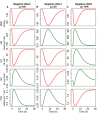Drug effects on the CVS in conscious rats: separating cardiac output into heart rate and stroke volume using PKPD modelling
- PMID: 24962208
- PMCID: PMC4253457
- DOI: 10.1111/bph.12824
Drug effects on the CVS in conscious rats: separating cardiac output into heart rate and stroke volume using PKPD modelling
Abstract
Background and purpose: Previously, a systems pharmacology model was developed characterizing drug effects on the interrelationship between mean arterial pressure (MAP), cardiac output (CO) and total peripheral resistance (TPR). The present investigation aims to (i) extend the previously developed model by parsing CO into heart rate (HR) and stroke volume (SV) and (ii) evaluate if the mechanism of action (MoA) of new compounds can be elucidated using only HR and MAP measurements.
Experimental approach: Cardiovascular effects of eight drugs with diverse MoAs (amiloride, amlodipine, atropine, enalapril, fasudil, hydrochlorothiazide, prazosin and propranolol) were characterized in spontaneously hypertensive rats (SHR) and normotensive Wistar-Kyoto (WKY) rats following single administrations of a range of doses. Rats were instrumented with ascending aortic flow probes and aortic catheters/radiotransmitters for continuous recording of MAP, HR and CO throughout the experiments. Data were analysed in conjunction with independent information on the time course of the drug concentration following a mechanism-based pharmacokinetic-pharmacodynamic modelling approach.
Key results: The extended model, which quantified changes in TPR, HR and SV with negative feedback through MAP, adequately described the cardiovascular effects of the drugs while accounting for circadian variations and handling effects.
Conclusions and implications: A systems pharmacology model characterizing the interrelationship between MAP, CO, HR, SV and TPR was obtained in hypertensive and normotensive rats. This extended model can quantify dynamic changes in the CVS and elucidate the MoA for novel compounds, with one site of action, using only HR and MAP measurements. Whether the model can be applied for compounds with a more complex MoA remains to be established.
© 2014 The British Pharmacological Society.
Figures





Similar articles
-
PKPD modelling of the interrelationship between mean arterial BP, cardiac output and total peripheral resistance in conscious rats.Br J Pharmacol. 2013 Aug;169(7):1510-24. doi: 10.1111/bph.12190. Br J Pharmacol. 2013. PMID: 23849040 Free PMC article.
-
Haemodynamic effects of dicentrine, a novel alpha 1-adrenoceptor antagonist: comparison with prazosin in spontaneously hypertensive and normotensive Wistar-Kyoto rats.Br J Pharmacol. 1992 Aug;106(4):797-801. doi: 10.1111/j.1476-5381.1992.tb14415.x. Br J Pharmacol. 1992. PMID: 1356567 Free PMC article.
-
Acute hemodynamic effects of ethanol in conscious spontaneously hypertensive and normotensive rats.Alcohol Clin Exp Res. 1999 Feb;23(2):285-92. Alcohol Clin Exp Res. 1999. PMID: 10069558
-
Acute effects of ethanol on cardiac output and its derivatives in spontaneously hypertensive and normotensive rats.J Pharmacol Exp Ther. 1994 Dec;271(3):1150-8. J Pharmacol Exp Ther. 1994. PMID: 7996420
-
Changes in arterial smooth muscle contractility, contractile proteins, and arterial wall structure in spontaneous hypertension.Proc Soc Exp Biol Med. 1994 Nov;207(2):148-74. doi: 10.3181/00379727-207-43802. Proc Soc Exp Biol Med. 1994. PMID: 7938046 Review.
Cited by
-
Quantitative pharmacokinetic-pharmacodynamic modelling of baclofen-mediated cardiovascular effects using BP and heart rate in rats.Br J Pharmacol. 2016 Oct;173(19):2845-58. doi: 10.1111/bph.13561. Epub 2016 Aug 25. Br J Pharmacol. 2016. PMID: 27448216 Free PMC article.
-
Applications of Quantitative Systems Pharmacology in Model-Informed Drug Discovery: Perspective on Impact and Opportunities.CPT Pharmacometrics Syst Pharmacol. 2019 Nov;8(11):777-791. doi: 10.1002/psp4.12463. Epub 2019 Oct 25. CPT Pharmacometrics Syst Pharmacol. 2019. PMID: 31535440 Free PMC article.
-
Evaluation of a Cardiovascular Systems Model for Design and Analysis of Hemodynamic Safety Studies.Pharmaceutics. 2023 Apr 7;15(4):1175. doi: 10.3390/pharmaceutics15041175. Pharmaceutics. 2023. PMID: 37111660 Free PMC article.
-
A tutorial for model-based evaluation and translation of cardiovascular safety in preclinical trials.CPT Pharmacometrics Syst Pharmacol. 2024 Jan;13(1):5-22. doi: 10.1002/psp4.13082. Epub 2023 Nov 23. CPT Pharmacometrics Syst Pharmacol. 2024. PMID: 37950388 Free PMC article.
-
Modeling and Simulation Approaches for Cardiovascular Function and Their Role in Safety Assessment.CPT Pharmacometrics Syst Pharmacol. 2015 Mar;4(3):e00018. doi: 10.1002/psp4.18. Epub 2015 Mar 11. CPT Pharmacometrics Syst Pharmacol. 2015. PMID: 26225237 Free PMC article. Review.
References
-
- Anderson BJ, Holford NH. Mechanistic basis of using body size and maturation to predict clearance in humans. Drug Metab Pharmacokinet. 2009;24:25–36. - PubMed
-
- Asdaq SM, Inamdar MN. The potential for interaction of hydrochlorothiazide with garlic in rats. Chem Biol Interact. 2009;181:472–479. - PubMed
-
- Belpaire FM, de Smet F, Vynckier LJ, Vermeulen AM, Rosseel MT, Bogaert MG, et al. Effect of aging on the pharmacokinetics of atenolol, metoprolol and propranolol in the rat. J Pharmacol Exp Ther. 1990;254:116–122. - PubMed
-
- Cardinale D, Bacchiani G, Beggiato M, Colombo A, Cipolla CM. Strategies to prevent and treat cardiovascular risk in cancer patients. Semin Oncol. 2013;40:186–198. - PubMed
Publication types
MeSH terms
Substances
LinkOut - more resources
Full Text Sources
Other Literature Sources
Medical

